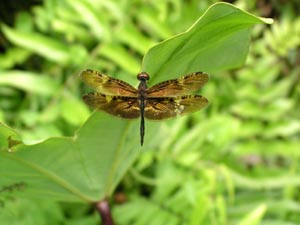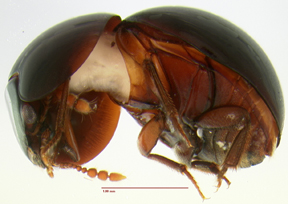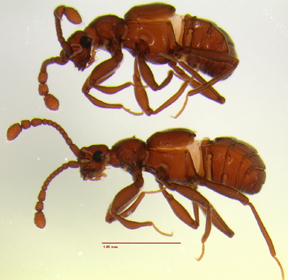
Research Interests
Michael Ferro

My earliest research was on Dragonflies (Odonata) in Missouri, and later in Thailand (see my Thailand trip page).
My masters research centered on Mayflies, Stoneflies, and Caddisflies
(Ephemeroptera,
 Plecoptera, and Trichoptera) of Missouri State Parks. As soon as
the .pdf of my thesis is placed on University of Missouri's website, I'll
provide a link.
Plecoptera, and Trichoptera) of Missouri State Parks. As soon as
the .pdf of my thesis is placed on University of Missouri's website, I'll
provide a link.
Presently my research centers around
communities of insects that can be found within fallen trees (logs). Grove 2002a
(linked below) is a wonderful synopsis of what the field has to offer. I would
like to compare several distinct places in North America to
provide a better understanding of the biotic and abiotic factors influencing
insect communities within decaying logs. Succession will be an important factor
to investigate as well as functional roles various taxa play in modifying and
creating suitable habitat for other insects and fungi. The elucidation of
functional guild communities of saproxylic insects will greatly facilitate an
understanding of the processes involved in coarse woody debris (CWD)
re-assimilation. This information is necessary for an understanding of the
overlooked and poorly understood processes of nutrient cycling, insect
colonization, competition, and succession in CWD, and most importantly loss of
species diversity due to logging of old growth forests, forest management, and
collection of CWD for fuel.
several distinct places in North America to
provide a better understanding of the biotic and abiotic factors influencing
insect communities within decaying logs. Succession will be an important factor
to investigate as well as functional roles various taxa play in modifying and
creating suitable habitat for other insects and fungi. The elucidation of
functional guild communities of saproxylic insects will greatly facilitate an
understanding of the processes involved in coarse woody debris (CWD)
re-assimilation. This information is necessary for an understanding of the
overlooked and poorly understood processes of nutrient cycling, insect
colonization, competition, and succession in CWD, and most importantly loss of
species diversity due to logging of old growth forests, forest management, and
collection of CWD for fuel.
Informal observations of insect communities under and within CWD throughout
temperate Missouri show striking differences from communities in dryer
environments such as Texas and Colorado, and wetter environments such as Belize
and Thailand. Initial literature searches for research concerning insect
communities that can be found within fallen logs and insect community succession
 during log decay show that few studies have catalogued species richness of saproxylic insects, the exceptions being research within Fennoscandia and a
recent ongoing study in Australia (Grove 2002a). Additionally, many papers have
stated that a greater awareness of the biodiversity dependent on CWD is needed
practically everywhere, especially the United States and tropical rain forests
(Harmon et al. 1986, Grove 2002a). Insects which use CWD are of particular
conservation concern, i.e. in Finland 151 (19%) of the saproxylic beetle species
are classified as threatened (Siitonen and Saaristo 2000), and prehistoric
extinction of saproxylic beetles in England correlates with reduction of mature
forest (Grove 2002b).
during log decay show that few studies have catalogued species richness of saproxylic insects, the exceptions being research within Fennoscandia and a
recent ongoing study in Australia (Grove 2002a). Additionally, many papers have
stated that a greater awareness of the biodiversity dependent on CWD is needed
practically everywhere, especially the United States and tropical rain forests
(Harmon et al. 1986, Grove 2002a). Insects which use CWD are of particular
conservation concern, i.e. in Finland 151 (19%) of the saproxylic beetle species
are classified as threatened (Siitonen and Saaristo 2000), and prehistoric
extinction of saproxylic beetles in England correlates with reduction of mature
forest (Grove 2002b).
Long term research is currently being conducted in Tasmania, concerning the ecology of log decay. That research centers around the biodiversity of saproxylic insects in decaying logs of two age classes, old growth and regrowth (Bashford, et al. 2001). Other studies in Europe have shown that 40-50% of beetles taken from mature forests are associated with dead wood (Grove 2002b) and findings imply that "dead wood may be the most important substrate for the maintenance of the diversity of insects, cryptograms, and fungi in the boreal forests" (Ehnstrom 2001). Evidence suggests that a large number of insect species are reliant on decaying logs world wide (Hammond 1990, Grove 2002a).
Literature Cited:
| Bashford, R.,
R. Taylor, M. Driessen, N. Doran, A. Richardson. 2001. Research on the
invertebrate assemblages at the Warra LTER Site. Tasforests.
13(1):109-129. |
| Ehnstrom, B.
2001. Leaving dead wood for insects in boreal forests - Suggestions
for the future. Scandinavian Journal of Forest Research, Supplement.
3:91-98. |
|
Grove, S. J.,
2002a, Saproxylic insect ecology and the sustainable management of
forests. Annual Review of Ecology and Systematics. 33:1-23. |
| Grove, S. J.,
2002b, The influence of forest management history on the integrity of
the saproxylic beetle fauna in an Australian lowland tropical
rainforest. Biological Conservation. 104:149-171. |
| Hammond, P.
M. 1990. Insect abundance and diversity in the Dumoga-Bone National
Park, N. Sulawesi, with special reference to the beetle fauna of
lowland rainforest in the Toraut region. In Insects and the Rain
Forests of South East Asia (Wallacea), ed. W. J. Knight, J. D.
Holloway, pp. 197-254. London: Royal Entomological Society of London. |
| Harmon, M.
E., J. F. Franklin, F. J. Swanson, P. Sollins, S. V. Gregory, J. D.
Lattin, N. H. Anderson, S. P. Cline, N. G. Aumen, J. R. Sedell, G. W.
Lienkaemper, K. Cromack, Jr., and K. W. Cummins. 1986. Ecology of
coarse woody debris in temperate ecosystems. Advances in Ecological
Research 15:133-302. |
| Siitonen, J. and L. Saaristo. 2000. Habitat requirements and conservation of Pytho kolwensis, a beetle species of old growth boreal forest. Biological Conservation. 94:211-220. |